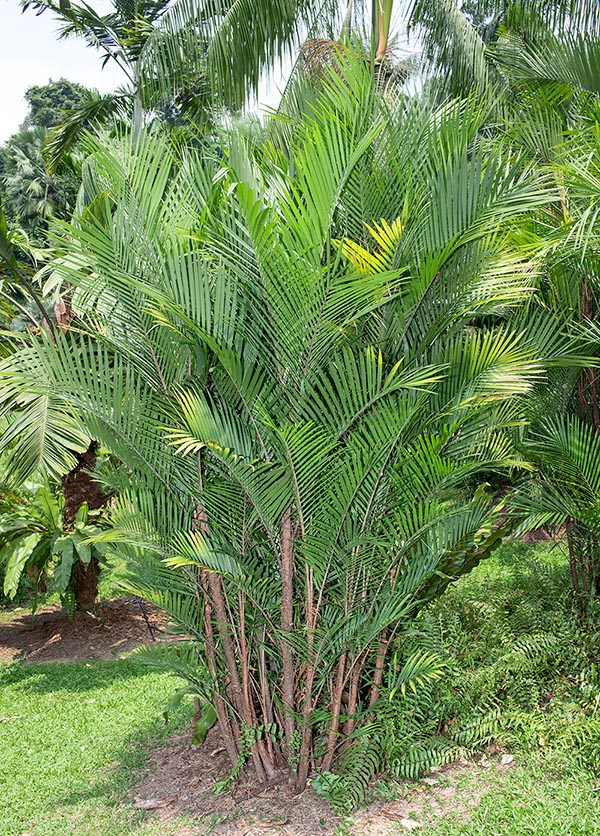Family : Arecaceae

Text © Pietro Puccio

English translation by Mario Beltramini

Native to tropical America, Bactris major forms dense tufts reaching the 10 m of height © Giuseppe Mazza
The generic name comes from the Greek substantive “βάκτρον” (bactron) = stick, support, with reference to the use of the stems of some species belonging to the genus as sticks; the specific name is the Latin comparative adjective of “magnus” = big.
Common names: beach palm, lata palm, prickly palm (English); beach spiny clubpalm, biscoyol, black roseau, cocano boy, hones, palma de espina (Belize); marayáu (Bolivia); marajá-açù, mumbaca, tucum-mirim (Brazil); corozo de gallina, lata (Colombia); huiscoyol, viscoyol (Costa Rica); guyscoyol (El Salvador); zagrinette (French Guyana); bordón, jahuacté (Mexico); coyolito (Nicaragua); caña brava, palma negra, uvito, uvito de parra (Panama); yarina (Peru); kaw-maka, samoera (Surinam); corozo de marea, cubarro, cucurito (Venezuela).
The Bactris major Jacq. (1781) is a monoecious species forming thick tufts with erect or slightly bent stems, 2-10 m tall and of 2-6 cm of diameter, covered by the foliare bases provided of robust blackish spines, up to 10 cm long, except in the oldest parts, smooth, of dark green colour and with the prominent and whitish rings of the foliar scares spaced of 12-25 cm.
The leaves, on a 0,3-1 m long petiole, are pinnate, 0,8-2,2 m long, with 24-46 pairs of oblong-linear pinnules regularly arranged along the rachis and on the same level, 25-60 cm long and 1-3 cm broad, with margin provided of tiny spines or bristles; petiole and rachis are covered by short spines interspersed by some brown or black spines, 1-6 cm long, except at the base of the petiole where they may exceed the 10 cm.
Ramified inflorescences among the leaves (interfoliar) initially enclosed in a spiny spathe, semi-woody and persistent in fruit, 35-60 cm long, with greenish yellow unisexual flowers usually arranged in triad (one female flower amid two males); the female flowers ripe before the male ones thus favouring the crossed pollination.

Galore spines but edible fruits. Ornamental employments and for impenetrable enclosures © G. Mazza
It reproduces by seed, in draining loam rich of organic substance maintained constantly humid at 26-28 °C, with quite long germination times, even more than one year, and by division.
Amply diffused in nature, but little cultivated, presents, despite the robust spines, a considerable ornamental potentiality as isolated group or for forming impenetrable barriers in parks and large gardens exclusively in tropical and subtropical climate zones, not bearing temperatures close to 0 °C, taking care to place it far away from passageways and resting places.
It requires full sun or slight shade and well drained soils, preferably sandy, with ample availability of water. The fruits, with yellowish pulp, juicy and having a slightly sourish taste, are amply consumed by the local populations as they are or utilized for getting refreshing and fermented beverages. The stems are used as poles for fences, in coverages, along with the leaves, of permanent or makeshift shelters and for fabricating baskets; due to their mechanical strength, flexibility and look they might be advantageously employed, deprived of spines and polished, even for realizing furniture and handicrafts.
Synonyms: Palma zagueneti Aubl. (1775); Bactris ovata Stokes (1812); Bactris chaetorhachis Mart. (1844); Bactris demerarana L.H.Bailey (1949); Bactris minax Miq. (1851); Augustinea major (Jacq.) H.Karst. (1857); Augustinea balanoidea Oerst. (1859); Augustinea ovata Oerst. (1859); Bactris cruegeriana Griseb. (1864); Pyrenoglyphis balanoidea (Oerst.) H.Karst. (1869); Pyrenoglyphis major (Jacq.) H.Karst. (1869); Pyrenoglyphis ovata (Oerst.) H.Karst. (1869); Bactris balanoidea (Oerst.) H.Wendl. (1878); Bactris ovata (Oerst.) H.Wendl. (1878); Bactris megalocarpa Trail ex Thurn (1882); Bactris ottostaffeana Barb. Rodr. (1907); Bactris ottostapfiana Barb.Rodr. (1907); Bactris augustinea L.H.Bailey (1933); Bactris superior L.H.Bailey (1933); Pyrenoglyphis chaetorhachis (Mart.) Burret (1934); Pyrenoglyphis ottostapfiana (Barb.Rodr.) Burret (1934); Pyrenoglyphis superior (L.H.Bailey) Burret (1934); Bactris albonotata L.H.Bailey (1947); Bactris beata L.H.Bailey (1947); Bactris broadwayi L.H.Bailey (1947); Bactris cateri L.H.Bailey (1947); Bactris ellipsoidalis L.H.Bailey (1947); Bactris obovoidea L.H.Bailey (1947); Bactris planifolia L.H.Bailey (1947); Bactris swabeyi L.H.Bailey (1947); Pyrenoglyphis cruegeriana (Griseb.) H.Karst. (1969); Bactris major var. megalocarpa (Trail ex Thurn) A.J.Hend. (1995).
→ For general notions about ARECACEAE please click here.
